Does Industrial Green Transformation Really Lead to High Land Use Efficiency? Evidence from China
Abstract
:1. Introduction
2. Theoretical Analysis and Research Hypotheses
3. Study Area, Data, and Methodology
3.1. Study Area
3.2. Data Sources
3.3. Methods
3.3.1. Measurement of the ILUE: Data Envelopment Analysis by the DEA-SBM Model
3.3.2. Measurement of the ILUE
3.3.3. Measurement of Industrial Industry Rationalization (ITL)
3.3.4. Measurement of Industrial Sector Upgrading (IW)
3.3.5. Measurement of Industrial Sector Industry Specialization Agglomeration (IKSL)
3.3.6. Measurement of Industrial Sector Industry Diversification Agglomeration (IDIV)
3.3.7. Industrial Sector Transformation on the ILUE Using the Spatial Durbin Model
Effect of Industrial Structure Optimization on the ILUE
Impact of the Industrial Space Layout on the ILUE
3.3.8. Industrial Transformation Effect on the Spatial and Temporal Heterogeneity of the ILUE
4. Results
4.1. Spatiotemporal Distribution of the ITL
4.2. Spatiotemporal Distribution of the IW
4.3. Spatiotemporal Distribution of the IKSL and IDIV
4.4. Spatiotemporal Distribution of the ILUE
4.5. Spatial Spillover Effects of Industrial Transformation on the ILUE
4.5.1. Spatial Spillover Effect of Industrial Structure Optimization on the ILUE
4.5.2. Spatial Spillover Effect of the Industrial Spatial Layout on the ILUE
4.5.3. Robustness Check
4.6. Industrial Transformation Effects on the Temporal and Spatial Heterogeneity of the ILUE
5. Discussion
6. Conclusions
Author Contributions
Funding
Data Availability Statement
Conflicts of Interest
References
- Pu, W.; Zhang, A.; Zhang, Z.; Qin, S.; Xia, Q. Can urban land market reform mitigate industrial emissions? Environmental evidence from 257 prefecture-level cities in China. Environ. Res. 2023, 236, 116707. [Google Scholar] [CrossRef] [PubMed]
- Tian, C.; Luan, W.; Wang, X.; Jin, X. Land price, government debt, and land-use efficiency in the coastal cities of China under the constraint of land scarcity. J. Environ. Manag. 2024, 371, 123144. [Google Scholar] [CrossRef]
- Geng, Y.; Li, X.; Chen, J. Integration of land use resilience and efficiency in China: Analysis of spatial patterns, differential impacts on SDGs, and adaptive management strategies. Appl. Geogr. 2025, 175, 103490. [Google Scholar] [CrossRef]
- Wu, X.; Zhong, S.; Chen, G.; Wu, C.; Wu, C.; Han, J.; Qian, Z. Influence of land use intensity on urban carbon efficiency under a carbon neutrality target: Evidence from the Yangtze River Delta urban agglomeration, China. Environ. Impact Assess. Rev. 2025, 110, 107689. [Google Scholar] [CrossRef]
- Qi, Y.; Lin, R.; Zhu, D. Impact of rising industrial land prices on land-use efficiency in China: A study of underpriced land price. Land Use Policy 2025, 151, 107490. [Google Scholar] [CrossRef]
- Jaber, S. Land use efficiency and governance disparities: Unveiling the nexus in the Arab world. Environ. Dev. 2025, 55, 101169. [Google Scholar] [CrossRef]
- Zhou, D.; Hu, Y.; Sun, Q.; Xie, D. Land resource mismatch and energy efficiency: Evidence from 243 cities in China. Energy Policy 2023, 183, 113800. [Google Scholar] [CrossRef]
- Zhang, H.; Zheng, J.; Hunjra, A.; Zhao, S.; Bouri, E. How does urban land use efficiency improve resource and environment carrying capacity? Socio-Econ. Plan. Sci. 2024, 91, 101760. [Google Scholar] [CrossRef]
- Li, B.; Wang, Z.; Xu, F. Exploring the effects of market-oriented reforms on industrial land use eco-efficiency in China: Evidence from a spatial and non-linear analysis. Environ. Impact Assess. Rev. 2023, 102, 107211. [Google Scholar] [CrossRef]
- Ma, L.; Xu, W.; Zhang, W.; Ma, Y. Effect and mechanism of environmental regulation improving the urban land use eco-efficiency: Evidence from China. Ecol. Indic. 2024, 159, 111602. [Google Scholar] [CrossRef]
- Zhang, N.; Sun, F.; Hu, Y. Carbon emission efficiency of land use in urban agglomerations of Yangtze River Economic Belt, China: Based on three-stage SBM-DEA model. Ecol. Indic. 2024, 160, 111922. [Google Scholar] [CrossRef]
- Yang, Y.; Xue, R.; Zhang, X.; Cheng, Y.; Shan, Y. Can the marketization of urban land transfer improve energy efficiency? J. Environ. Manag. 2023, 329, 117126. [Google Scholar] [CrossRef] [PubMed]
- Lei, J.; Xie, Y.; Chen, Y.; Zhong, T.; Lin, Y.; Wang, M. The Transformation of Peri-Urban Agriculture and Its Implications for Urban–Rural Integration Under the Influence of Digital Technology. Land 2025, 14, 375. [Google Scholar] [CrossRef]
- Gao, X.; Zhang, A.; Sun, Z. How regional economic integration influence on urban land use efficiency? A case study of Wuhan metropolitan area, China. Land Use Policy 2019, 90, 104329. [Google Scholar] [CrossRef]
- Kvartiuk, V.; Bukin, E.; Herzfeld, T. “For whoever has will be given more”? Land rental decisions and technical efficiency in Ukraine. Land Use Policy 2024, 146, 107336. [Google Scholar] [CrossRef]
- Su, B.; Shen, X.; Wang, Q.; Zhang, Q.; Niu, J.; Yin, Q.; Chen, Y.; Zhou, S. The Evolution and Performance Response of Industrial Land Use Development in China’s Development Zone: The Case of Suzhou Industrial Park. Land 2024, 13, 2182. [Google Scholar] [CrossRef]
- Wang, F.; Zhang, H.; Zhou, J. Impact of Green Finance on Chinese Urban Land Green Use Efficiency: An Empirical Study Based on a Quasinatural Experiment. Land 2025, 14, 332. [Google Scholar] [CrossRef]
- Gao, M.; Shao, Z.; Zhang, L.; Qiao, Z.; Yang, Y.; Zhao, L. Coupling and Coordination Relationship Between Carbon Emissions from Land Use and High-Quality Economic Development in Inner Mongolia, China. Land 2025, 14, 354. [Google Scholar] [CrossRef]
- Wu, Y.; Luo, M. Study on Spatial-Temporal Evolution Law of Green Land Use Efficiency in Resource-Based Cities. Land 2025, 14, 360. [Google Scholar] [CrossRef]
- Zhang, X.; Yang, M.; Guo, R.; Li, Y.; Zhong, F. Land Use Transition and Regional Development Patterns Under Shared Socioeconomic Pathways: Evidence from Prefecture-Level Cities in China. Land 2025, 14, 454. [Google Scholar] [CrossRef]
- Zhang, H.; Song, Y.; Zhang, M.; Duan, Y. Land use efficiency and energy transition in Chinese cities: A cluster-frontier super-efficiency SBM-based analytical approach. Energy 2024, 304, 132049. [Google Scholar] [CrossRef]
- Lu, X.; Jiang, X.; Gong, M. How land transfer marketization influence on green total factor productivity from the approach of industrial structure? Evidence from China. Land Use Policy 2020, 95, 104610. [Google Scholar] [CrossRef]
- Chen, W.; Shen, Y.; Wang, Y.; Wu, Q. The effect of industrial relocation on industrial land use efficiency in China: A spatial econometrics approach. J. Clean. Prod. 2018, 205, 525–535. [Google Scholar] [CrossRef]
- Chen, W.; Chen, W.; Ning, S.; Liu, E.; Zhou, X.; Wang, Y.; Zhao, M. Exploring the industrial land use efficiency of China’s resource-based cities. Cities 2019, 2019, 215–223. [Google Scholar] [CrossRef]
- Han, W.; Zhang, Y.; Cai, J.; Ma, E. Does Urban Industrial Agglomeration Lead to the Improvement of Land Use Efficiency in China? An Empirical Study from a Spatial Perspective. Sustainability 2019, 11, 986. [Google Scholar] [CrossRef]
- Yin, G.; Lin, Z.; Jiang, X.; Qiu, M.; Sun, J. How do the industrial land use intensity and dominant industries guide the urban land use? Evidences from 19 industrial land categories in ten cities of China. Sustain. Cities Soc. 2019, 53, 101978. [Google Scholar] [CrossRef]
- Liu, J.; Hou, X.; Wang, Z.; Shen, Y. Study the effect of industrial structure optimization on urban land-use efficiency in China. Land Use Policy 2021, 105, 105390. [Google Scholar] [CrossRef]
- Flynn, H.; Canals, L.; Keller, E.; King, H.; Sim, S.; Hasting, A.; Wang, S.; Smith, P. Quantifying global greenhouse gas emissions from land-use change for crop production. Glob. Change Biol. 2012, 18, 1622–1635. [Google Scholar] [CrossRef]
- Xu, L.; Tan, J. Financial development, industrial structure and natural resource utilization efficiency in China. Resour. Policy 2020, 66, 101642. [Google Scholar] [CrossRef]
- Koroso, N.; Lengoiboni, M.; Zevenbergen, J. Urbanization and urban land use efficiency: Evidence from regional and Addis Ababa satellite cities, Ethiopia. Habitat Int. 2021, 117, 102437. [Google Scholar] [CrossRef]
- Xie, H.; Wang, W.; Yang, Z.; Choi, Y. Measuring the sustainable performance of industrial land utilization in major industrial zones of China. Technol. Forecast. Soc. Change 2016, 112, 207–219. [Google Scholar] [CrossRef]
- Guastella, G.; Pareglio, S.; Sckokai, P. A spatial econometric analysis of land use efficiency in large and small municipalities. Land Use Policy 2017, 63, 288–297. [Google Scholar] [CrossRef]
- Mao, W.; Wang, W.; Sun, H.; Yao, P.; Wang, X.; Luo, D. Urban industrial transformation patterns under natural resource dependence: A rule mining technique. Energy Policy 2021, 156, 112383. [Google Scholar] [CrossRef]
- Jiang, W.; Luo, S.; Zhou, G. Financial development, OFDI spillovers and upgrading of industrial structure. Technol. Forecast. Soc. Change 2020, 155, 119974. [Google Scholar] [CrossRef]
- Matsumoto, H. International urban systems and air passenger and cargo flows: Some calculations. J. Air Transp. Manag. 2004, 10, 239–247. [Google Scholar] [CrossRef]
- Balassa, B.; Toutjesdijk, A. Economic integration among developing countries. J. Common Mark. Stud. 1975, 14, 37–55. [Google Scholar] [CrossRef]
- Auer, P. Protected mobility for employment and decent work: Labour market security in a globalized world. J. Ind. Relat. 2006, 48, 21–40. [Google Scholar] [CrossRef]
- Hall, P.; Pain, K. The Polycentric Metropolis: Learning from Mega-City Regions in Europe; Routledge: Abingdon-on-Thames, UK, 2006. [Google Scholar]
- Tian, Y.; Jiang, G.; Ma, W.; Wu, S.; Tian, Y.; Zhou, T. Understanding the relationship between population–land–industry element inputs and function outputs of rural settlement: An efficiency-based perspective. Habitat Int. 2025, 159, 103370. [Google Scholar] [CrossRef]
- Chen, W.; Ning, S.; Chen, W.; Liu, E.; Wang, Y.; Zhao, M. Spatial-temporal characteristics of industrial land green efficiency in China: Evidence from prefecture-level cities. Ecol. Indic. 2020, 113, 106256. [Google Scholar] [CrossRef]
- Cobb, C.; Douglas, P. A theory of production. Am. Econ. Rev. 1928, 18, 139–165. [Google Scholar]
- Pu, W.; Zhang, A. Can China’s Market-Oriented Reform Improve the Efficiency of Industrial Land Use? A Panel Data Empirical Analysis at Prefecture Level From 2007–2019. Front. Environ. Sci. 2022, 10, 884958. [Google Scholar] [CrossRef]
- Zhao, L.; Sun, C.; Zheng, D. Measurement of inter-provincial water resources utilization efficiency and spatial spillover effect in China. Acta Geogr. Sin. 2014, 69, 121–133. [Google Scholar] [CrossRef]
- Chen, S.; Jefferson, G.; Zhang, J. Structural change, productivity growth and industrial transformation in China. China Econ. Rev. 2011, 22, 133–150. [Google Scholar] [CrossRef]
- Huang, Z.; He, C.; Zhu, S. Do China’s economic development zones improve land use efficiency? The effects of selection, factor accumulation and agglomeration. Landsc. Urban Plan. 2017, 162, 145–156. [Google Scholar] [CrossRef]
- Gan, C.; Zheng, R.; Yu, D. The impact of China’s industrial structure changes on economic growth and fluctuations. Econ. Res. 2011, 46, 4–16+31. [Google Scholar]
- Bai, Z.; Han, L.; Liu, H.; Li, L.; Jiang, X. Assessment of coordinated development between urban land use efficiency and ecological carrying capacity: Case study of the cities in Inner Mongolia. Ecol. Indic. 2023, 155, 110933. [Google Scholar] [CrossRef]
- Zhang, W.; Wu, Q.; Wang, B.; Huang, J. Multidimensional study on the impact of industrial specialization and diversified agglomeration on urban land use efficiency. Chin. Popul. Resour. Environ. 2019, 29, 100–110. [Google Scholar]
- Xiang, S.; Zhou, M.; Huang, L.; Shan, L.; Wang, K. Assessing the dynamic land utilization efficiency and relevant driving mechanism in in-situ urbanized rural areas: A case study of 1979 administrative villages in Hangzhou. Environ. Impact Assess. Rev. 2023, 101, 107111. [Google Scholar] [CrossRef]
- Wang, H.; Liu, Y.; Sun, L.; Ning, X.; Li, G. Assessment of Chinese urban land-use efficiency (SDG11.3.1) utilizing high-precision urban built-up area data. Geogr. Sustain. 2025, 6, 100210. [Google Scholar] [CrossRef]
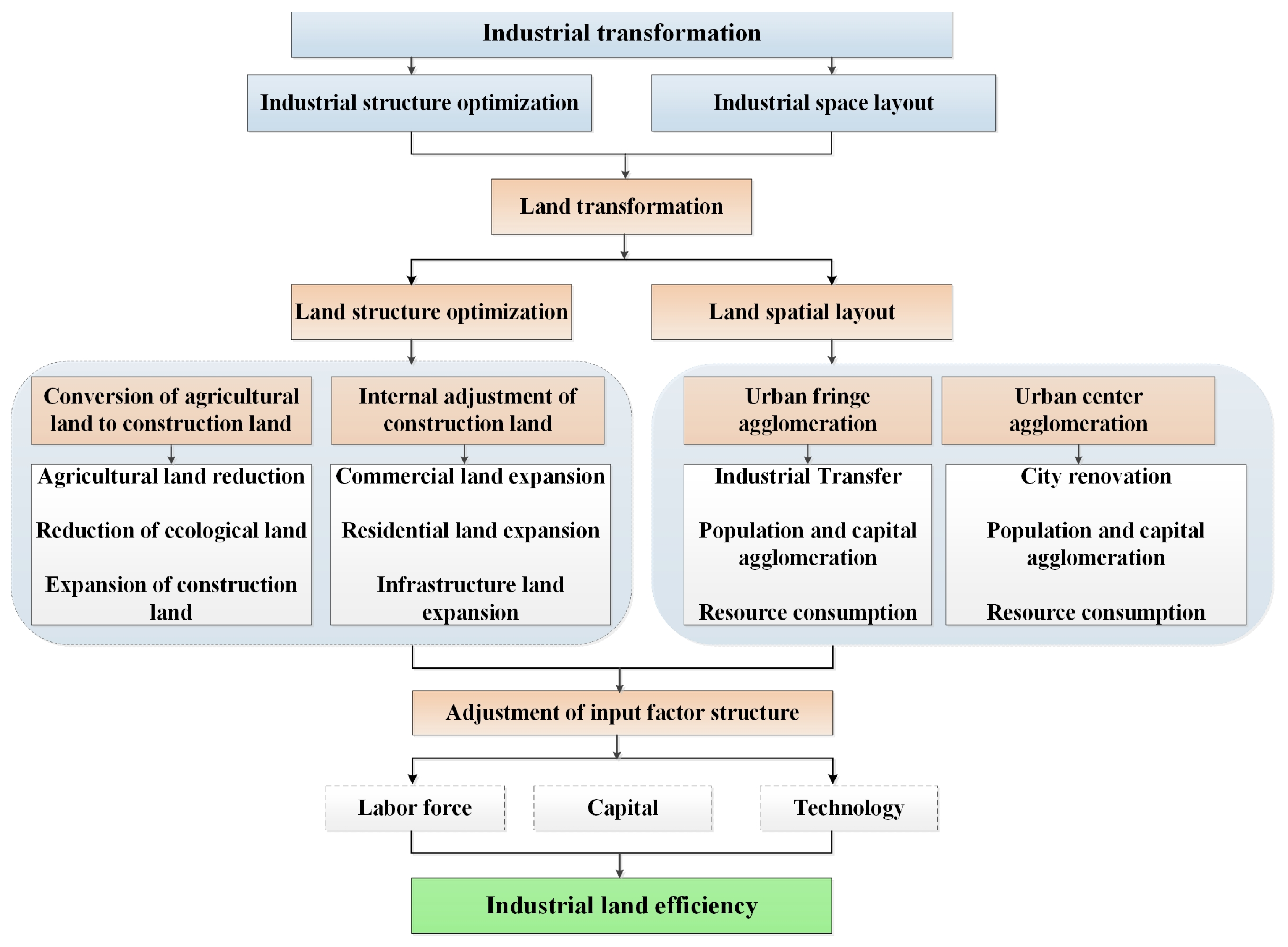


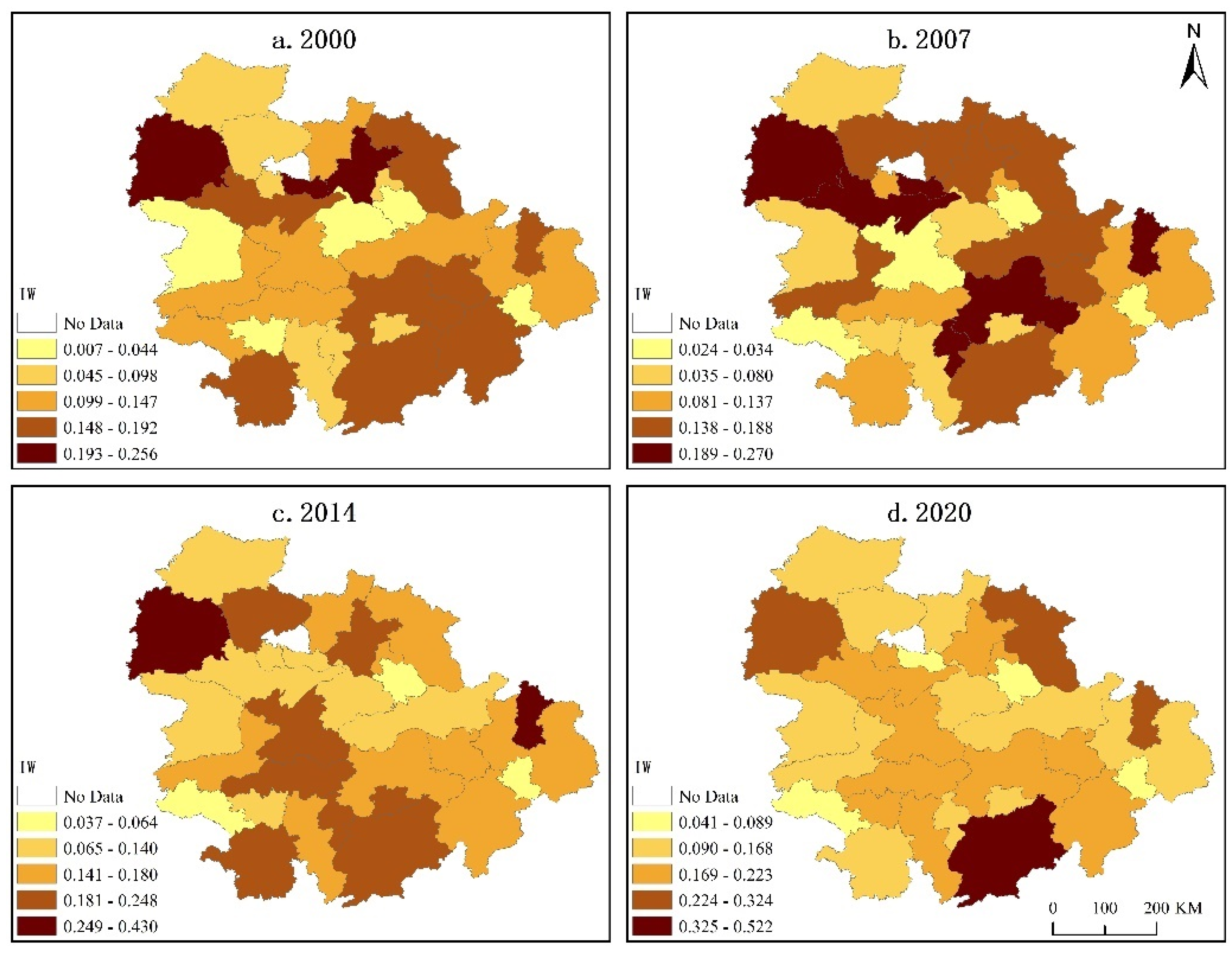
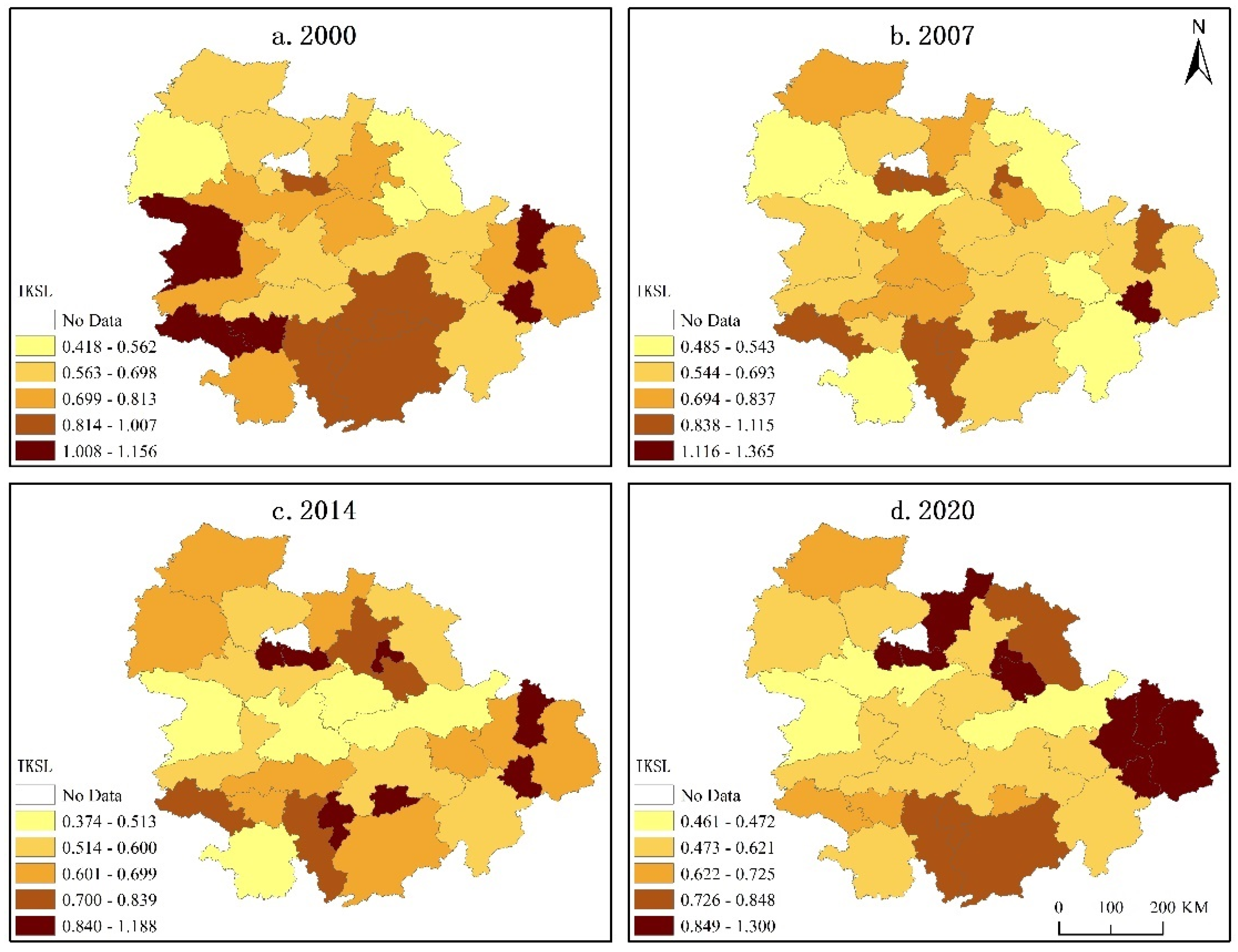
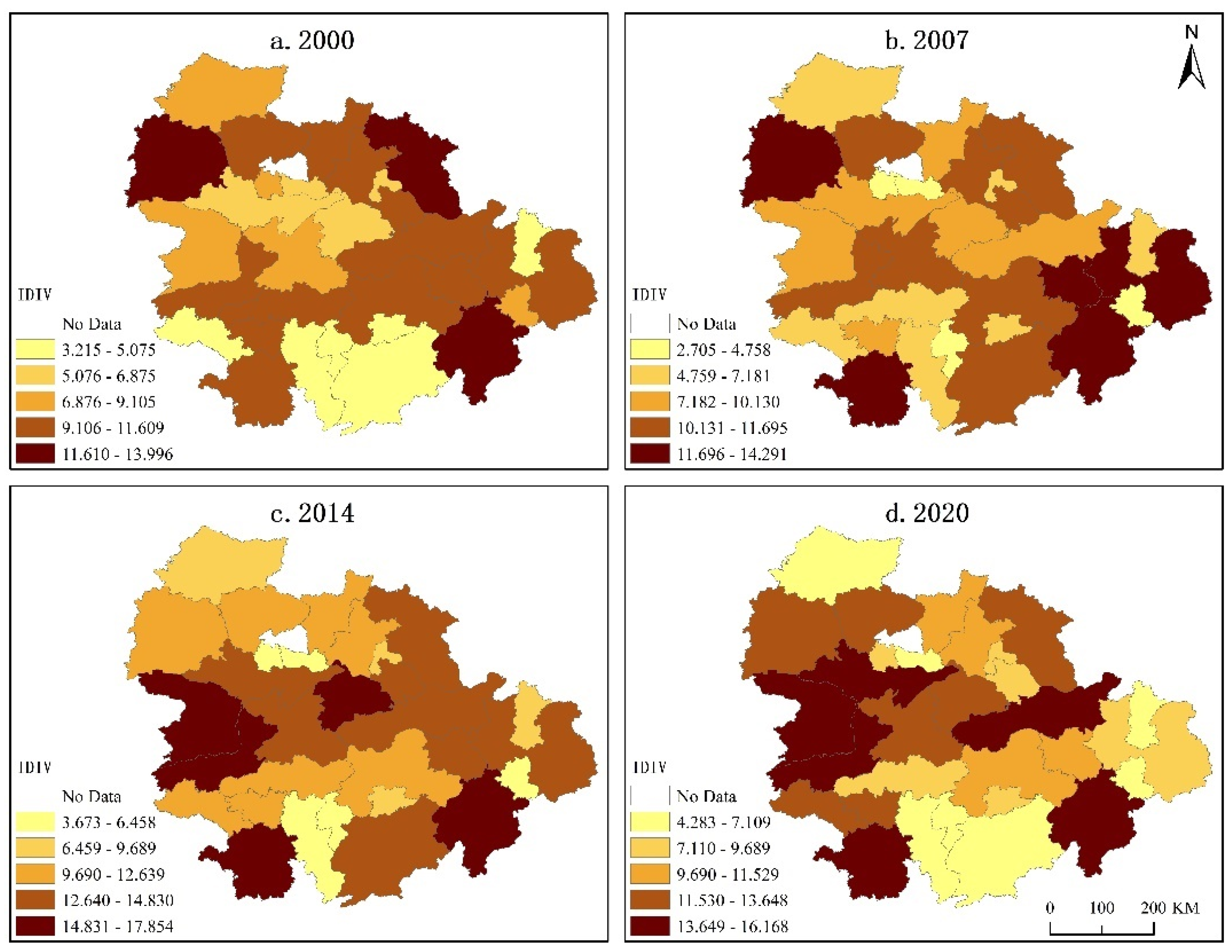
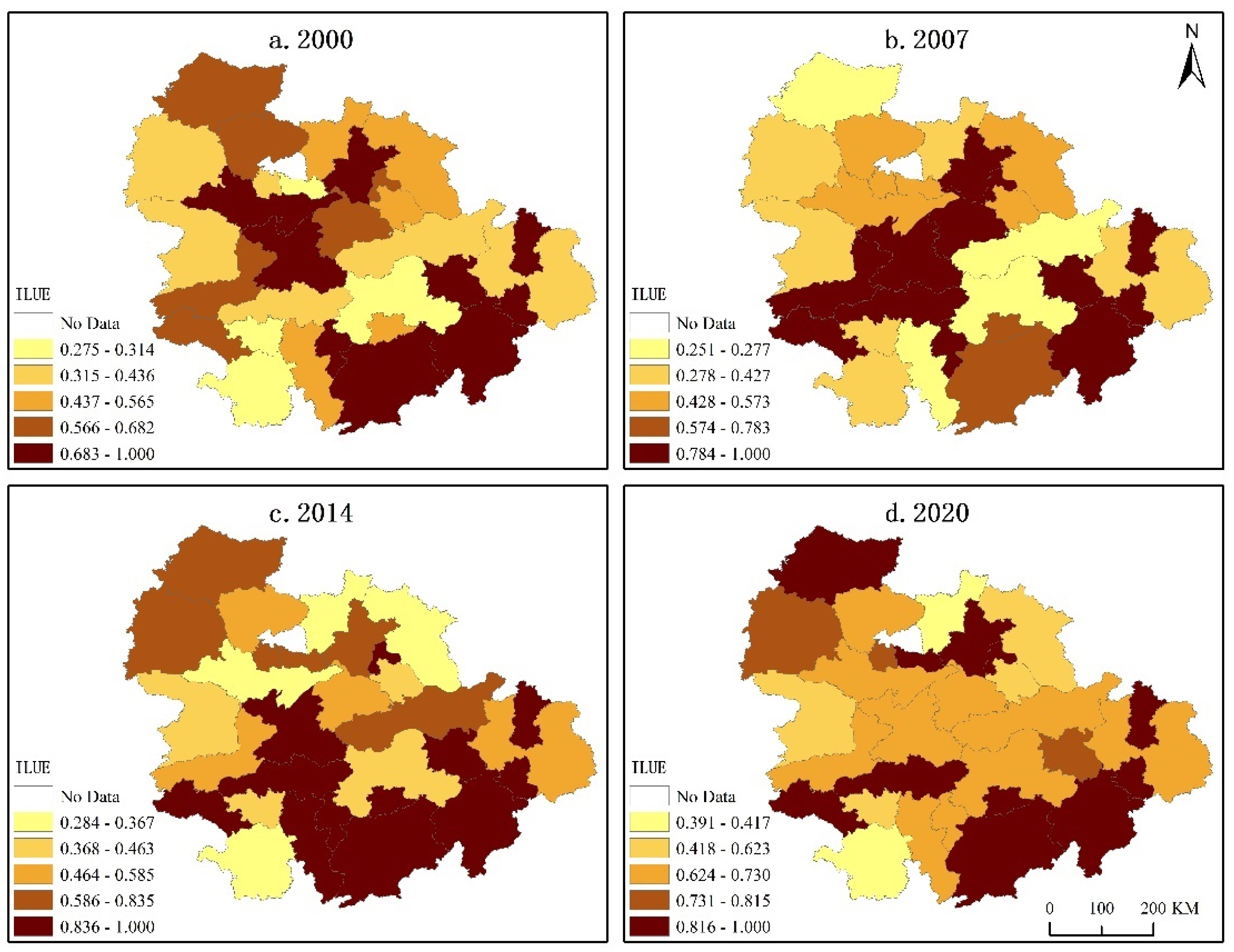
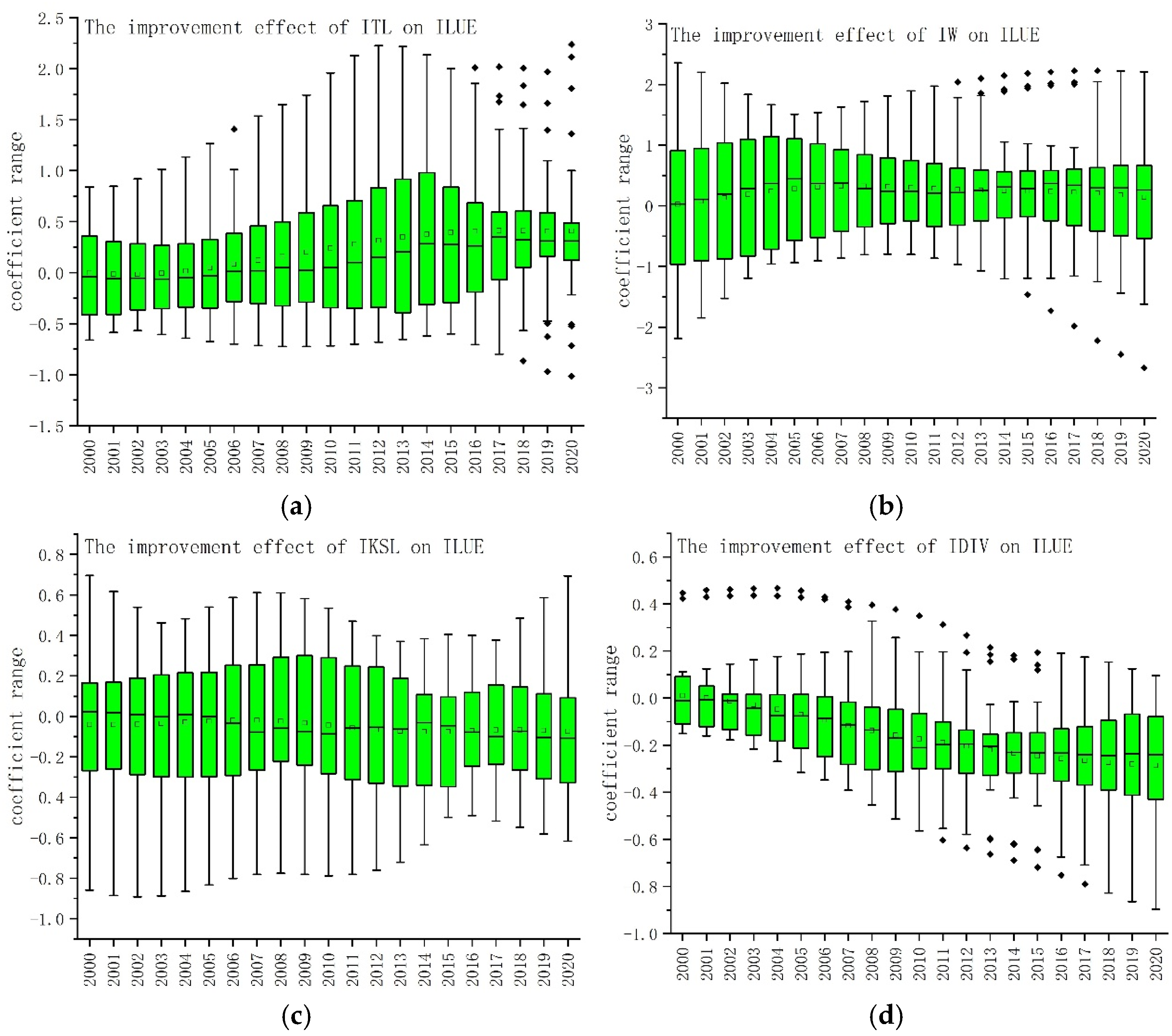
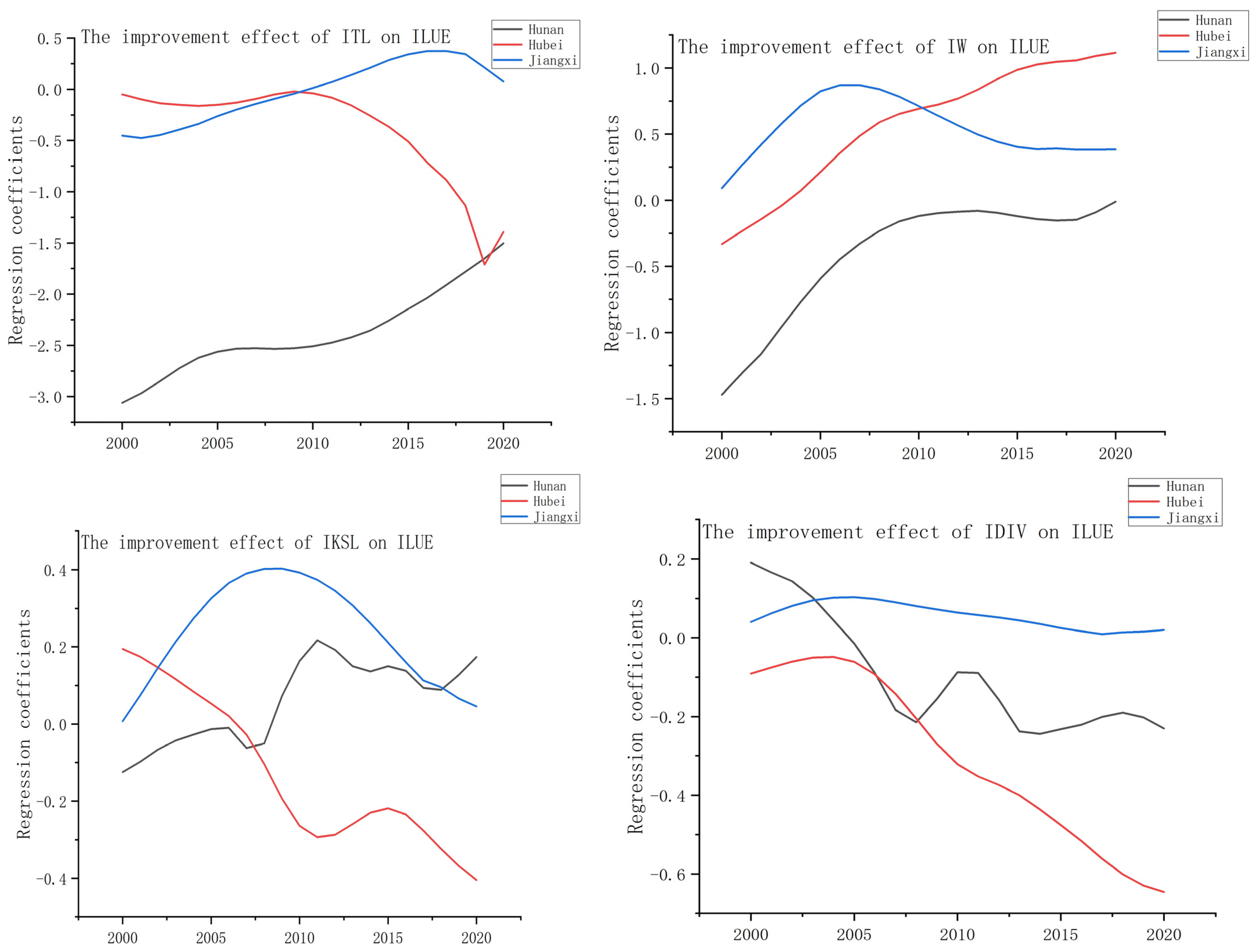
| Indicator Selection | Classification Indicator | Single Indicator | Unit |
|---|---|---|---|
| Input variable | Land | Industrial land area | Hectare |
| Labor force | Secondary industry employment | Thousands of people | |
| Capital | Industrial fixed asset investment | Billion RMB | |
| Desired output | Economic output | Industrial output | Billion RMB |
| Undesired output | Environmental pollution | ||
| Carbon emission | Million tons |
| Variable | Meaning | Mean | Std | Min | Max |
|---|---|---|---|---|---|
| ILUE | Industrial land efficiency | 0.688 | 0.266 | 0.215 | 1 |
| ITL | Industrial industry rationalization | 0.097 | 0.083 | 0.004 | 0.549 |
| IW | Industrial industry upgrading | 0.147 | 0.073 | 0.007 | 0.522 |
| IKSL | Industrial industry specialization agglomeration | 0.767 | 0.215 | 0.091 | 1.441 |
| InIDIV | Industrial industry diversified agglomeration | 2.219 | 0.435 | 0.747 | 2.924 |
| InGDP | The level of economic development | 15.888 | 1.072 | 13.198 | 18.905 |
| KJB | Technology investment | 0.005 | 0.007 | 0.00001 | 0.057 |
| InGZ | Urban residents’ wages | 10.106 | 0.781 | 7.999 | 11.586 |
| SCHL | Land marketization level | 0.701 | 0.332 | 0.063 | 1 |
| CZB | Government management | 0.142 | 0.060 | 0.032 | 0.394 |
| ILUE | Adjacency Distance | Economic Distance | Economic Geography Nesting | ||||||
|---|---|---|---|---|---|---|---|---|---|
| rho | 0.228 *** (4.090) | 0.251 *** (3.120) | 0.156 *** (4.42) | ||||||
| direct effect | indirect effect | total effect | direct effect | indirect effect | total effect | direct effect | indirect effect | total effect | |
| ITL | 0.099 (0.660) | 0.271 (1.010) | −0.370 (1.380) | 0.066 (0.450) | 0.832 ** (2.580) | −0.898 *** (2.780) | 0.114 (0.78) | 0.079 (0.42) | −0.193 (0.95) |
| IW | −0.155 (−1.020) | −0.128 (−0.310) | 0.283 (−0.620) | −0.157 (−1.060) | −0.247 (−0.370) | 0.405 (−0.590) | 0.269 * (−1.80) | −0.324 (1.52) | 0.055 (0.20) |
| InGDP | 0.136 *** (3.320) | −0.194 ** (−2.040) | 0.058 (−0.590) | 0.134 *** (3.080) | −0.014 (−0.100) | 0.120 (0.880) | 0.122 *** (3.21) | −0.215 *** (−4.25) | 0.093 (−1.55) |
| KJB | −0.814 (−0.710) | 1.518 (1.030) | 0.704 (0.500) | −1.398 (−1.090) | 2.772 (1.290) | 1.373 (0.790) | 0.431 (0.39) | −0.650 (−0.53) | 0.219 (−0.19) |
| CZB | 0.266 (1.010) | −0.227 (−0.370) | −0.039 (0.060) | 0.325 (1.250) | −1.094 (−1.020) | −0.770 (−0.700) | 0.282 (1.11) | −0.604 * (−1.81) | −0.322 (−0.79) |
| InGZ | 0.088 (1.430) | 0.065 (0.630) | 0.153 (1.520) | 0.027 (0.440) | 0.057 (0.450) | 0.084 (0.710) | 0.010 (0.19) | 0.200 *** (3.37) | 0.211 *** (3.31) |
| SCHL | 0.034 (0.690) | −0.083 (−0.960) | −0.049 (−0.580) | 0.058 (1.270) | −0.205 (−1.560) | −0.147 (−1.070) | 0.097 ** (2.05) | −0.207 *** (−3.48) | −0.111 * (−1.68) |
| R2 | 0.012 | 0.007 | 0.015 |
| ILUE | Adjacency Distance | Economic Distance | Economic Geography Nesting | ||||||
|---|---|---|---|---|---|---|---|---|---|
| Rho | 0.240 *** (4.410) | 0.257 *** (3.240) | 0.157 *** (4.450) | ||||||
| direct effect | indirect effect | total effect | direct effect | indirect effect | total effect | direct effect | indirect effect | total effect | |
| IKsl | −0.084 (−1.370) | 0.343 *** (2.960) | 0.259 ** (2.160) | −0.054 (−0.900) | 0.532 *** (3.020) | 0.479 *** (2.600) | −0.077 (−1.320) | 0.264 *** (3.640) | 0.188 ** (2.090) |
| InIDiv | −0.095 *** (−2.680) | 0.112 (1.430) | 0.017 (0.200) | −0.082 ** (−2.330) | 0.257 ** (2.340) | 0.176 (1.560) | 0.074** (−2.150) | −0.071 * (1.650) | 0.003 (−0.050) |
| InGDP | 0.123 *** (3.100) | −0.178 * (−1.900) | −0.055 (−0.570) | 0.122 *** (2.860) | −0.109 (−0.810) | 0.013 (0.100) | 0.112*** (3.040) | −0.191 *** (−3.960) | −0.079 (−1.400) |
| KJB | −0.510 (−0.450) | 2.093 (1.410) | 1.583 (1.130) | −1.100 (−0.870) | 4.061 * (1.740) | 2.961 (1.560) | 0.580 (0.530) | −0.426 (−0.350) | 0.154 (0.130) |
| CZB | 0.326 (1.290) | −0.509 (−0.860) | −0.183 (−0.280) | 0.375 (1.480) | −1.386 (−1.260) | −1.011 (−0.890) | 0.372 (1.530) | −0.789 ** (−2.390) | −0.417 (−1.020) |
| InGZ | 0.091 (1.570) | 0.044 (0.430) | 0.135 (1.330) | 0.042 (0.710) | 0.082 (0.640) | 0.124 (1.030) | 0.036 (0.710) | 0.163 *** (2.830) | 0.199 *** (3.140) |
| SCHL | 0.034 (0.710) | −0.072 (−0.840) | −0.038 (−0.460) | 0.070 (1.530) | −0.201 (−1.560) | −0.131 (−0.970) | 0.074 * (1.650) | −0.196 *** (−3.310) | −0.121 * (−1.940) |
| R2 | 0.012 | 0.017 | 0.023 |
| Explained Variable ILUE | |||
|---|---|---|---|
| Explanatory variable | Direct effect | Indirect effect | Total effect |
| ITL | 0.069 *** (3.020) | 0.145 ** (−2.550) | −0.214 * (−1.910) |
| IW | 0.164 (−0.890) | 0.200 (−0.390) | 0.364 (−0.64) |
| InGDP | 0.135 *** (2.950) | −0.114 (−1.040) | 0.021 (0.180) |
| KJB | −0.601 (−0.490) | 2.183 (1.390) | 1.582 (1.020) |
| CZB | 0.086 (0.250) | −0.234 (−0.320) | −0.148 (−0.180) |
| InGZ | 0.057 (0.790) | −0.008 (−0.070) | 0.048 (0.380) |
| SCHL | 0.011 (0.210) | −0.419 (−0.440) | −0.030 (−0.330) |
| Rho | 0.222 *** (3.660) | ||
| R2 | 0.034 |
| Explained variable ILUE | |||
|---|---|---|---|
| Explanatory variable | Direct effect | Indirect effect | Total effect |
| IKsl | 0.111 (−1.630) | 0.377 *** (2.950) | 0.266 ** (2.030) |
| InIDiv | −0.102 ** (−2.520) | 0.169 ** (1.850) | 0.067 *** (3.020) |
| InGDP | 0.130 *** (2.910) | −0.103 (−0.920) | 0.028 (0.240) |
| KJB | −0.194 (−0.160) | 2.422 (1.550) | 2.228 (1.500) |
| CZB | 0.195 (0.600) | −0.502 (−0.700) | −0.307 (−0.380) |
| InGZ | 0.063 (0.940) | −0.036 (−0.300) | 0.027 (0.210) |
| SCHL | 0.010 (0.180) | −0.031 (−0.340) | −0.022 (−0.240) |
| Rho | 0.230 *** (3.860) | ||
| R2 | 0.053 |
Disclaimer/Publisher’s Note: The statements, opinions and data contained in all publications are solely those of the individual author(s) and contributor(s) and not of MDPI and/or the editor(s). MDPI and/or the editor(s) disclaim responsibility for any injury to people or property resulting from any ideas, methods, instructions or products referred to in the content. |
© 2025 by the authors. Licensee MDPI, Basel, Switzerland. This article is an open access article distributed under the terms and conditions of the Creative Commons Attribution (CC BY) license (https://creativecommons.org/licenses/by/4.0/).
Share and Cite
Pu, W.; Liu, M.; Zhang, A. Does Industrial Green Transformation Really Lead to High Land Use Efficiency? Evidence from China. Land 2025, 14, 1110. https://doi.org/10.3390/land14051110
Pu W, Liu M, Zhang A. Does Industrial Green Transformation Really Lead to High Land Use Efficiency? Evidence from China. Land. 2025; 14(5):1110. https://doi.org/10.3390/land14051110
Chicago/Turabian StylePu, Wenfang, Mengba Liu, and Anlu Zhang. 2025. "Does Industrial Green Transformation Really Lead to High Land Use Efficiency? Evidence from China" Land 14, no. 5: 1110. https://doi.org/10.3390/land14051110
APA StylePu, W., Liu, M., & Zhang, A. (2025). Does Industrial Green Transformation Really Lead to High Land Use Efficiency? Evidence from China. Land, 14(5), 1110. https://doi.org/10.3390/land14051110







